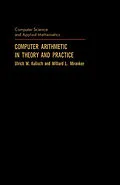Computer Arithmetic in Theory and Practice deals with computer arithmetic and the various implementations of the entire arithmetic package on diverse processors, including microprocessors. It illustrates the importance of theoretical development in the sound implementation of arithmetic on computers, and argues that such an implementation requires the establishment of various isomorphisms between different definitions of arithmetic operations.
Comprised of seven chapters, this volume begins with an introduction to the theory of computer arithmetic by giving an axiomatic characterization of the essential properties of sets and subsets; complete lattices and complete subnets; screens and roundings; and arithmetic operations. The discussion then turns to the concepts of a ringoid and a vectoid as well as those of ordered or weakly ordered ringoids and vectoids; interval arithmetic; and floating-point arithmetic. The operations in interval spaces are defined by means of semimorphisms. The final chapter shows how to embed the five basic data types (integer, real, complex, real interval, and complex interval) together with the arithmetic operations that are defined for all of these types into existing higher programming languages.
This book will be helpful to students and practitioners in the fields of computer science and applied mathematics.
Inhalt
Preface
Introduction and Preliminary Definition of Computer Arithmetic
Part 1. Theory of Computer Arithmetic
Chapter 1. First Concepts
1. Ordered Sets
2. Complete Lattices and Complete Subnets
3. Screens and Roundings
4. Arithmetic Operations and Roundings
Chapter 2. Ringoids and Vectoids
1. Ringoids
2. Vectoids
3. Completely Ordered Ringoids and Vectoids
Chapter 3. Definition of Computer Arithmetic
1. Introduction
2. Preliminaries
3. The Vertical Definition of Computer Arithmetic
4. The Horizontal Definition of Computer Arithmetic by Semimorphisms
5. A Remark about Roundings
Chapter 4. Interval Arithmetic
1. Interval Sets and Arithmetic
2. Interval Arithmetic over a Linearly Ordered Set
3. Interval Matrices
4. Interval Vectors
5. Interval Arithmetic on a Screen
6. Interval Matrices and Interval Vectors on a Screen
7. Complex Interval Arithmetic
8. Complex Interval Matrices and Vectors
Part 2. Implementation of Arithmetic on Computers
Chapter 5. Floating-Point Arithmetic
1. Definition and Properties of the Real Numbers
2. Floating-Point Numbers and Roundings
3. Floating-Point Operations
4. Extended Floating-Point Arithmetic
Chapter 6. Implementation of Floating-Point Arithmetic on a Computer
1. The Level 1 Routines
2. Introductory Remarks about the Level 2 Routines
3. Addition and Subtraction
4. Normalization
5. Rounding
6. Multiplication
7. Division
8. Algorithms Using the Short Accumulator
9. Underflow and Overflow Treatment
10. Computation with Maximum Accuracy of the Sum of n Floating-Point Numbers
11. An Alternative Algorithm for Computing the Sum of n Floating-Point Numbers
12. The Level 3 Routines
Chapter 7. Computer Arithmetic and Programming Languages
1. Introduction
2. General Description of the Language Extension
3. Arithmetic Standard Functions of the Language Extension
4. Syntax of the Language Extension
5. Syntax Variables Used in the Diagrams
References
Glossary of Symbols and Formulas
Index
